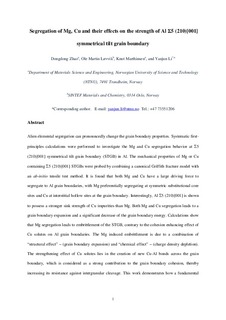| dc.contributor.author | Zhao, Dongdong | |
| dc.contributor.author | Løvvik, Ole Martin | |
| dc.contributor.author | Marthinsen, Knut | |
| dc.contributor.author | Li, Yanjun | |
| dc.date.accessioned | 2017-12-29T09:29:34Z | |
| dc.date.available | 2017-12-29T09:29:34Z | |
| dc.date.created | 2017-12-27T18:49:04Z | |
| dc.date.issued | 2018 | |
| dc.identifier.citation | Acta Materialia. 2018, 145, 235-246. | nb_NO |
| dc.identifier.issn | 1359-6454 | |
| dc.identifier.uri | http://hdl.handle.net/11250/2473848 | |
| dc.description.abstract | Alien elemental segregation can pronouncedly change the grain boundary properties. Systematic first-principles calculations were performed to investigate the Mg and Cu segregation behavior at Σ5 (210)[001] symmetrical tilt grain boundary (STGB) in Al. The mechanical properties of Mg or Cu containing Σ5 (210)[001] STGBs were probed by combining a canonical Griffith fracture model with an ab-initio tensile test method. It is found that both Mg and Cu have a large driving force to segregate to Al grain boundaries, with Mg preferentially segregating at symmetric substitutional core sites and Cu at interstitial hollow sites at the grain boundary. Interestingly, Al Σ5 (210)[001] is shown to possess a stronger sink strength of Cu impurities than Mg. Both Mg and Cu segregation leads to a grain boundary expansion and a significant decrease of the grain boundary energy. Calculations show that Mg segregation leads to embrittlement of the STGB, contrary to the cohesion enhancing effect of Cu solutes on Al grain boundaries. The Mg induced embrittlement is due to a combination of “structural effect” ‒ (grain boundary expansion) and “chemical effect” ‒ (charge density depletion). The strengthening effect of Cu solutes lies in the creation of new Cu-Al bonds across the grain boundary, which is considered as a strong contribution to the grain boundary cohesion, thereby increasing its resistance against intergranular cleavage. This work demonstrates how a fundamental theoretical understanding on the atomic and electronic level can rationalize mechanical properties of alloys at the macroscopic scale. | nb_NO |
| dc.language.iso | eng | nb_NO |
| dc.publisher | Elsevier | nb_NO |
| dc.rights | Attribution-NonCommercial-NoDerivatives 4.0 Internasjonal | * |
| dc.rights.uri | http://creativecommons.org/licenses/by-nc-nd/4.0/deed.no | * |
| dc.title | Segregation of Mg, Cu and their effects on the strength of Al S5 (210) [001] symmetrical tilt grain boundary | nb_NO |
| dc.type | Journal article | nb_NO |
| dc.type | Peer reviewed | nb_NO |
| dc.description.version | acceptedVersion | nb_NO |
| dc.source.pagenumber | 235-246 | nb_NO |
| dc.source.volume | 145 | nb_NO |
| dc.source.journal | Acta Materialia | nb_NO |
| dc.identifier.doi | https://doi.org/10.1016/j.actamat.2017.12.023 | |
| dc.identifier.cristin | 1532246 | |
| dc.relation.project | Norges forskningsråd: 222173 | nb_NO |
| dc.relation.project | Notur/NorStore: nn9347k | nb_NO |
| dc.description.localcode | © 2017 Acta Materialia Inc. Published by Elsevier Ltd. All rights reserved. This is the authors' accepted and reviewed manuscript to the article, locked until 21 December 2019 due to copyright restrictions. | nb_NO |
| cristin.unitcode | 194,66,35,0 | |
| cristin.unitname | Institutt for materialteknologi | |
| cristin.ispublished | true | |
| cristin.fulltext | postprint | |
| cristin.qualitycode | 2 | |

